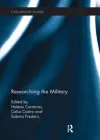Researching the Military
Edited by Helena Carreiras, Celso Castro and Sabina Frederic
Routledge, 2016,
ISBN 1138309249, 221pp
Reviewed by: Major Cate Carter
Conducting social research on the military is a complex endeavour. It involves theoretical traditions from a multitude of disciplines and a variety of methodological approaches. There are unique challenges to studying an organisation which has restricted access and often hazardous working conditions, and researchers need to approach their projects in innovative and flexible ways. Researching the Military is a welcome addition to Routledge’s Cass Military Studies series and features such innovation and flexibility by presenting the ‘historical, social, institutional and personal factors’ which contribute to the military researcher’s experience.
The central theme of the book is ‘reflexivity’ which the editors describe through examinations of the role of the researcher, the relationship of the researcher to the object of study, the positioning of the researcher in their institution, the impact of findings on policy, and the researcher’s own military experience. This edited edition consists of 15 essays written by military researchers from European, Middle Eastern, South American and African universities, each studying their own national armed force. Each chapter offers a personal account of the author’s research process and their perception of the relative success of different fieldwork methods.
The editors themselves begin the volume with a defence of reflexivity as a necessary surveillance tool but observe its relative immaturity in the field of armed forces and society. Eyal Ben-Ari offers a possible reason for this when he notes the divergence in military sociological topics studied by researchers in the United States and those in Western Europe, and suggests that this might be due to the latter being better ‘boundary spanners’ with ‘roles that actively mediate information and knowledge between two organizations’. The question of insider/outsider identity when dealing with the military is also examined by Lindy Heinecken in her chapter on research conducted by non-government organisations and think tanks in South Africa. A study from Slovenian academics Ljubica Jelusic, Janja Vuga Bersnak and Julija Jelusic Juznic, on the gap between academic findings and operational needs, offers one of the most useful chapters for Australian Defence Force researchers. The authors note that dissemination of findings to those who have the ability to make change is often missed because of the priority of effort put on the commissioning of the research rather than its application. These researchers also find that academic and scientific language is often a barrier to understanding the findings, and that researchers often do not get opportunities to interpret that language for the military community.
Rachel Woodward provides a much-appreciated chapter defining military geographies. Traditional military geography (applying geographical tools and techniques to solving military problems) has, she says, been influenced by a critical approach which investigates:
… ways in which militarism, militarization and military activities are constituted though space and expressed across space, with the understanding that these processes and outcomes operate at a range of scales from the personal to the international.
The author sees personal interactions with military landscapes as a vital tool in the researcher’s kit to understand space and environment and expression of military power.
The studies from South American scholars include Piero C Leirner’s fascinating exploration of the relationship between anthropology and the state, and the ways anthropological ideas such as ‘culture’ have been politicised and even weaponised through military adoption. Rosana Guber and Sabina Frederic provide chapters on ethnographic research in Argentina. Editor Celso Castro’s reflection on interviewing members of the Brazilian armed forces discusses access and identity as it relates to the insider/outsider perception. Immersion in the military environment is also discussed by Claude Weber and Alicia Payor y Pastor, who both studied
the French armies from a variety of perspectives including civilian, veteran, reservist, soldier, officer and PhD student. Both pose the question ‘Is the researcher a participating observer or an observing participant?’
A gender perspective is provided by Cristina Rodrigues da Silva in a report of her research on military families on the Brazilian Amazon border; in an account of collecting women’s narratives of their military service in Israel by Edna Lomsky-Feder and Orna Sasson-Levy; and in an account of experiences researching in the NATO environment in Bosnia Herzegovina and Italy by Teresa Ammendola, Fatima Farina and Maria Grazia Galentino. Finally, David Segal and Mady Wechsler Segal write an engaging reflection on their professional and personal partnership, their research and teaching experience and their influence on security policy, all against the evolution of military sociology in the United States over the last 50 years.
Researching the Military is a valuable handbook for civilian and military researchers alike and for those who craft policy in the defence sector. Its editors have brought together a contemporary collection of research experiences and challenges in the dynamic environment of modern militaries. Through these experiences of reflexive practice, we can learn not only how we might improve our own research methods but also what obstacles we as a military organisation must dismantle. As the editors claim, ‘The type of ties between the military and the academic world is one of the factors that condition the possibility of successful engagement.’


